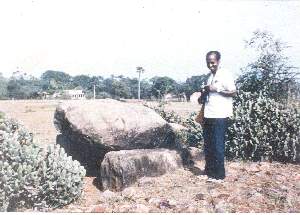
Home | Biodata | Biography | Photo Gallery | Publications | Tributes
Archaeology

 |
Home | Biodata | Biography | Photo Gallery | Publications | Tributes Archaeology |
 |
At a plenary session of the Second International Conference of Tamil Studies held in January 1968 at Madras, it was stated that the earliest beginnings of civilization called the Neolithic Culture are found all over South India except the extreme south, viz. Tirunelveli district.1 In this note we report the occurrence of a Polished Stone Axe from the extreme south of the peninsula and that of another from the southern portion of the West Coast.
The earliest traces of man in South India go back about 200,000 years and Old Stone Age implements have been found in large numbers in and around Madras including Tambaram. These are rough stone implements made of quartzite and the implements are said to belong to the Paleolithic period. The next period called the Mesolithic period is placed around 8000-2000 B.C. The people of this period used microliths or very small tools of stone and these implements are found in the teris or fossil sand-dunes of Tirunelveli district. The next stage is known as the Neolithic or Polished Stone Axe culture and the period is fixed around 2500-900 B.C. using carbon dating techniques. In this period man built houses for the first time, grew horse-gram and ragi, made fine pottery and used polished stone implements. These implements are made from closely grained basaltic rock which is found in the Shevaroy hills of Salem district. Polished Stone Axe can split, with ease and speed, a casuarina log over a foot in diameter and can be used to cut down an oak tree eight inches in diameter without injury to the blade.2
A couple of years ago the author with Mr I. Job Thomas of our College, visited the prehistoric burial site at Aadichanallur and found a polished stone axe at the site. This site has been known to archaeologists for almost a century for its urn burial, pottery and iron implements. Also a few ornaments in gold, bronze and shell as well as animal figurines in bronze have been found in the place. This introduction of metals such as iron and bronze took place after the Neolithic period.
Aadichanallur is about 18 kms. from Tirunelveli on the Tirunelveli-Srivaikuntam road which cuts through the mound on the southern bank of Taampraparni river. At about 200 feet from the Archaeological Department sign-board, bits of broken pottery were lying around and several more could be seen in the exposed part of the mound. At about 3 feet below the surface of the mound and 6 feet above the road level a polished stone axe was discovered from the exposed portion. The axe is made from basaltic rock,3 has a specific gravity of 3.01 and is of the blunted-butt type.
About 5 years ago Mr George K. Mathew, the present editor of the College Magazine brought a stone axe from Kerala.This was of the pointed-butt type with a specific gravity of 3.15 and made from basaltic rock. This piece was collected by a labourer on the ground at Mulakazha near Chengannur which is about 115 kms. north of Trivandrum on the Main Central Road. The site is about 3 kms. from the southern bank of the Pampa river in Kerala, and about 25 kms. from the sea. Up to 1960 the map showing the Neolithic sites of India4 has no marks on the west coast.
We have reported the occurrence of a pointed-butt axe from the southern end of the west coast from the Pampa river bank and more intensive search in that area may yield more artifacts. The occurrence of the blunted-butt axe at Aadichanallur may point to one of three different hypotheses. Either the Neolithic people lived at Aadichanallur before the iron-age people or the transition from stone-age to iron-age took place without any break at Aadichanallur or the iron-age people continued to use the stone implements after several hundred years just as we continue to use the grinding stones of the past in the 20th century!
1 H. D. Sankalia, Beginning of Civilization in South India, p. 9.
2 H. D. Sankalia, Stone Age Tools, p. 84, Deccan College, Poona, 1964.
3 This identification was made with the help of Dr S. K. Sen of the Department of Geology, Indian Institute of
Technology, Kharagpur, who was on a visit to Tambaram.
4 V. D.Krishnaswami, 'Neolithic Pattern of India', Ancient India, No.16, pp. 25-64, 1960.
 Stone-axe from Aadichanallur-3 views |  Stone-axe from Kerala-3 views |